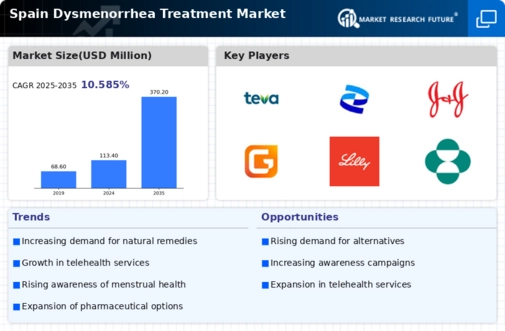The Spain Dysmenorrhea Treatment Market presents a diverse landscape characterized by various players offering a range of pharmaceutical solutions targeting the symptoms associated with dysmenorrhea. With an increasing awareness of women's health issues, the demand for effective treatment options has driven the market's growth.
A multitude of companies are vying for market share, each aiming to establish a stronger foothold in this dynamic sector through innovative products, marketing strategies, and patient-centered approaches. The competitive environment is influenced by factors such as product efficacy, pricing, distribution networks, and the extent of partnerships with healthcare providers.
Additionally, regulatory frameworks play a significant role in shaping the strategies companies adopt to cater to the needs of the Spanish population suffering from dysmenorrhea.Teva Pharmaceutical Industries has established a solid presence in the Spain Dysmenorrhea Treatment Market, driven by its commitment to providing affordable and accessible therapeutic options. The company's strengths lie in its extensive portfolio of generic medications and branded products that address dysmenorrhea-related pain effectively. Teva's strong R&D capabilities enable it to continually innovate, adapting to changing patient needs and preferences.
The company has developed a reputation for its production efficiency and market responsiveness, allowing it to maintain a competitive edge. Furthermore, strong relationships with healthcare professionals and stakeholders within the Spanish healthcare system enhance Teva's market position, ensuring that its offerings remain well-aligned with the evolving treatment landscape.
HoffmannLa Roche holds a significant position in the Spain Dysmenorrhea Treatment Market, with a robust lineup of prescription medications that target pain relief and symptom management for women experiencing dysmenorrhea. The company benefits from its well-established brand recognition and a strong focus on research and development aimed at enhancing women's health.
HoffmannLa Roche's strengths include its innovative solutions as well as an extensive distribution network that ensures its products are readily available across Spain. The company has also engaged in strategic partnerships and collaborations, enhancing its resources for new product development and market penetration. Mergers and acquisitions have further propelled HoffmannLa Roche's market presence, enabling it to expand its therapeutic offerings and maintain a competitive advantage in the rapidly evolving landscape of dysmenorrhea treatment.
























